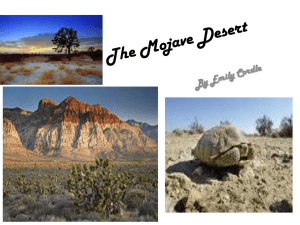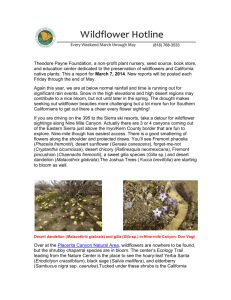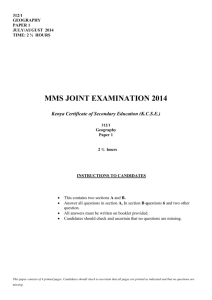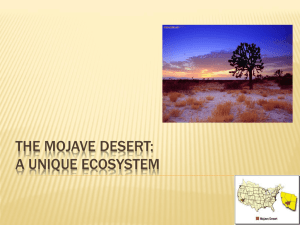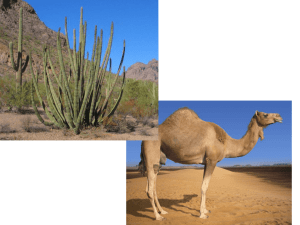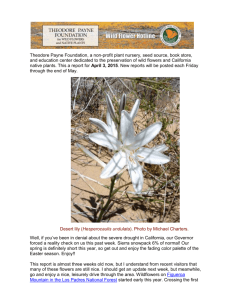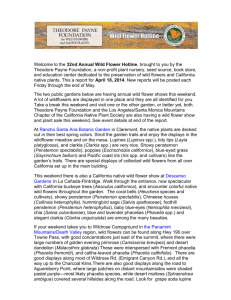March 14, 2014 – Word Doc - Theodore Payne Foundation
advertisement
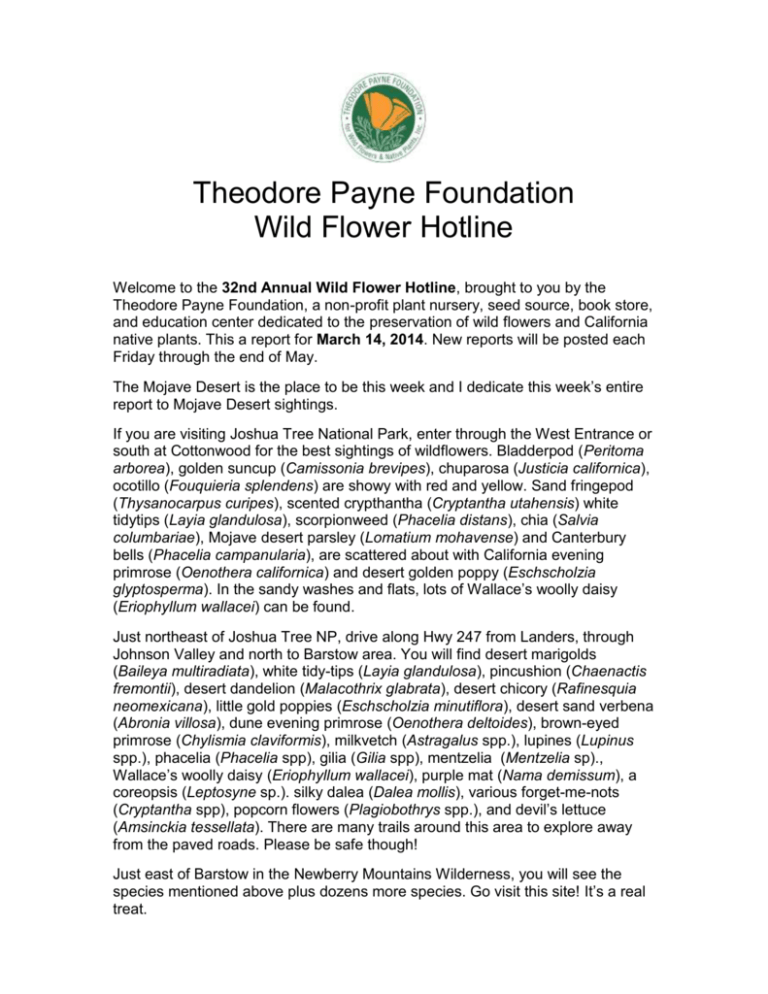
Theodore Payne Foundation Wild Flower Hotline Welcome to the 32nd Annual Wild Flower Hotline, brought to you by the Theodore Payne Foundation, a non-profit plant nursery, seed source, book store, and education center dedicated to the preservation of wild flowers and California native plants. This a report for March 14, 2014. New reports will be posted each Friday through the end of May. The Mojave Desert is the place to be this week and I dedicate this week’s entire report to Mojave Desert sightings. If you are visiting Joshua Tree National Park, enter through the West Entrance or south at Cottonwood for the best sightings of wildflowers. Bladderpod (Peritoma arborea), golden suncup (Camissonia brevipes), chuparosa (Justicia californica), ocotillo (Fouquieria splendens) are showy with red and yellow. Sand fringepod (Thysanocarpus curipes), scented crypthantha (Cryptantha utahensis) white tidytips (Layia glandulosa), scorpionweed (Phacelia distans), chia (Salvia columbariae), Mojave desert parsley (Lomatium mohavense) and Canterbury bells (Phacelia campanularia), are scattered about with California evening primrose (Oenothera californica) and desert golden poppy (Eschscholzia glyptosperma). In the sandy washes and flats, lots of Wallace’s woolly daisy (Eriophyllum wallacei) can be found. Just northeast of Joshua Tree NP, drive along Hwy 247 from Landers, through Johnson Valley and north to Barstow area. You will find desert marigolds (Baileya multiradiata), white tidy-tips (Layia glandulosa), pincushion (Chaenactis fremontii), desert dandelion (Malacothrix glabrata), desert chicory (Rafinesquia neomexicana), little gold poppies (Eschscholzia minutiflora), desert sand verbena (Abronia villosa), dune evening primrose (Oenothera deltoides), brown-eyed primrose (Chylismia claviformis), milkvetch (Astragalus spp.), lupines (Lupinus spp.), phacelia (Phacelia spp), gilia (Gilia spp), mentzelia (Mentzelia sp)., Wallace’s woolly daisy (Eriophyllum wallacei), purple mat (Nama demissum), a coreopsis (Leptosyne sp.). silky dalea (Dalea mollis), various forget-me-nots (Cryptantha spp), popcorn flowers (Plagiobothrys spp.), and devil’s lettuce (Amsinckia tessellata). There are many trails around this area to explore away from the paved roads. Please be safe though! Just east of Barstow in the Newberry Mountains Wilderness, you will see the species mentioned above plus dozens more species. Go visit this site! It’s a real treat. If you are on your way to Death Valley National Park, along the stretch of interstate between Barstow and Baker seems like a “yellow brick road of desert dandelion (Malacothrix glabrata), blooming strangely enough with fields of (Pectis papposa) which is a dominant fall blooming species. A whacky year, no doubt, but incredible displays can be seen north of Calico where yellows cover the floor of Creosote bush scrub for as far as the eye can see. You will also notice desert lily (Hesperocallis undulata) too if you’re hunting around safely on a side road, parked off the pavement — Lilies are plentiful this year! Desert lily (Hesperocallis undulata). Photo By Michael Charters Wallace’s woolly daisy (Eriophyllum wallacei). Photo by Michael Charters Driving in Death Valley National Park, the area of the Black Mountains between Jubilee Pass and Salsberry Pass on highway 178 is incredibly rich with wild flowers. You’ll see all sorts of things, including many forget-me-nots (Cyrptantha spp.), lupines (Lupinus spp.), and evening-primroses (Oenothera spp.), (Camissonia spp.) (Camissoniopsis spp.), and (Chylismia spp.). You will also likely see gorgeous displays of desert dandelion (Malacothrix glabrata), (Chaenactis sp.), desert mallow (Sphaeralcea ambigua) and desert five spot (Eremalche rotundifolia). A great show it is out there considering the dry year. But you do need to get out of the car and walk around Navigate over to the western Mojave Desert, west of Victorville, up to Saddleback Butte and Mojave to see carpets of coreopsis (Leptosyne sp.). Also look for colorful groupings of scorpion weed (Phacelia distans), fiddleneck (Amsinckia tessellata), desert dandelion (Malacothrix glabrata), Parry’s linanthus (Linanthus parryae), pale primrose (Oenothera sp.), Mojave suncup (Camissonia sp.) and Mojave lupine (Lupinus odoratus). Hugging the sandy open areas are Pringle’s woolly daisy (Eriophyllum pringlei), owl’s clover (Castilleja densiflora), golden gilia (Leptosiphon aureus), and mentzelia (Mentzelia sp.). Coreopsis at Saddleback Butte. Photos by Sharon Morgan Jenkins Wildflowers around the Lake Los Angeles area include, Mojave coreopsis (Leptosyne sp.), Mojave pincushion (Chaenactis sp.), and at Saddleback Butte, you will find California tickseed (Leptosne sp.) in abundance. Other nice species, especially in the Kramer Junction region include desert dandelion (Malacothrix glabrata), pincushion (Chaenactis sp.), desert sand verbena (Abronia villosa), scalebud (Anisocoma acaulis), and goldfields (Lasthenia sp.). Just north and northeast of the Devil's Punchbowl County Park, along Hwy138, the desert is in full bloom. Look for white tidy tips (Layia glandulosa), goldfields (Lasthenia sp.), desert dandelion (Malacothrix glabrata),Wallace’s woolly daisy (Eriophyllum wallacei), pincushion (Chaenactis sp.), crowned muilla (Muilla coronata), broad-flowered gilia (Gilia latiflora), cobwebby gilia (Loeseliastrum sp.), Parry’s linanthus (Linanthus parryae), fiddleneck (Amsinkia tessellata), phacelias (Phacelia spp.), forget-me-nots (Cryptantha spp.), thistle sage (Salvia carduacea), and purple sage (Salvia dorrii). The soil was quite damp under these, so hopefully more to come! White Tidy Tips (Layia glandulosa). Photo by Sharon Morgan Jenkins If you are driving on the 395 to the Sierra ski resorts, take a detour for wildflower sightings along Nine Mile Canyon. Actually there are 3 or 4 canyons coming out of the Eastern Sierra just above the Inyo/Kern County border that are fun to explore. Nine-mile though has easiest access. There is a good smattering of flowers along the shoulder and protected canyon draws. You’ll see Fremont phacelia (Phacelia fremontii), desert sunflower (Geraea canescens), forget-menot (Cryptantha cicumcissa), desert chicory (Rafinesquia neomexicana), Fremont pincushion (Chaenactis fremontii), a sweet gilia species (Gilia sp.) and desert dandelion (Malacothrix glabrata).The Joshua Trees (Yucca brevifolia) are starting to bloom as well. That’s it for this week. Look for our next report on Friday, March 21st and check back each week for the most up to date information on southern and central California wildflowers. If you would like to be a wildflower reporter send your information about wildflower blooms and their location to flowerhotline@theodorepayne.org by Wednesday of each week when blooms of note occur. NATIVE PLANT & WILDFLOWER EVENTS: Theodore Payne Foundation Poppy Day Plant Sale Saturday, March 29, 8:30am-4:30pm An annual celebration of our State flower and huge native plant sale, offering the region’s largest and most interesting selection of California native plants – with expert advice and discounts to all! TPF members 15% off plants; non-members 10%; memberships available at the door. 11th Annual Theodore Payne Native Plant Garden Tour Saturday & Sunday, April 5 & 6, 10:00am-5:00pm Self-driven tour showcasing 42 beautiful and sustainable Los Angeles-area gardens, each planted with at least 50% California natives. New for 2014: contemporary art installations at 12 locations! Tickets: TPF members $15/both days; non-members $20. Purchase online (and see photos and details) at nativeplantgardentour.org, by phone to 818 768-1802 or in person at TPF. Native Plant Week Symposium, Wildflower Show & Plant and Book Sale Saturday, April 19, 9:00am-4:00pm Cosponsored by the Theodore Payne Foundation and California Native Plant Society, LA/Santa Mountains Chapter Sepulveda Garden Center, 16633 Magnolia Blvd, Encino 91436 A full day of inspiring talks, wild flower displays, exhibits, demonstrations, childrens’ activities, native plant sale, book and poster sales, and more! Free admission; snacks for sale. Details at lacnps.org. Hikes: Riverside County: Harford Springs Preserve Flower Walk. Sunday, March 16, 9 am – 12:30 pm. Reservations: Call 951.785.7452 California Native Plant Society Events Riverside-San Bernardino Chapter CNPS North Etiwanda Preserve Field Trip Saturday, March 22, 9am to 1pm. Assemble in the parking area by the preserve entrance at the north end of Etiwanda Ave. This is the main access point to the trail system. The preserve is located north of Hwy 210 and Rancho Cucamonga at the base of the San Gabriel Mountains. For trail map, see: http://sbcnep.org/ San Diego Chapter CNPS Otay Mountain Wilderness, Saturday, march 22, 8:30 am. - 4:00 pm. Rain at 7 am cancels the field trip. Meet at 8:30 at the CA Dept. Fish and Wildlife Rancho Jamul Ecological Reserve, 14715 State Highway 94 in Jamul. Caravan from there. Send email to Kay at fieldtrips@cnps.org to reserve your spot. Kay’s number (619) 917-2668. Los Angeles/SMM Chapter CNPS Point Mugu State Park, 10:00 am, Sunday, March 23 - Ray Miller Trailhead Fire-following Wild Flower Walk. Bring water, snack, lunch (if you want to linger after the walk). Meet at the Ray Miller Trail from the La Jolla Valley Trailhead parking lot; parking fee in the lot; park free on PCH and walk in. Info: 818-782-9346. 2-3hrs.
